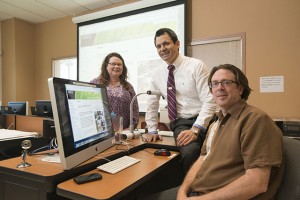CSUN Connects to Local Community Through Robotics Academy
Students at Canoga Park High School, Columbus Middle School and Hart Street Elementary in the San Fernando Valley are diligently working on their latest homework assignment — to build a robot.
With guidance from California State University, Northridge director of the Neighborhood Partners in Action (NPA) initiative Douglas Kaback and elementary education professor John Reveles, the K-12 students are exposed to a nationally recognized and more hands-on approach to science, technology, engineering and mathematics (STEM) in their classrooms.

CSUN education professor John Reveles, center, stands with fellow education professor Brian Foley, right, and biology professor Virginia Vandergon, left. Photo by Lee Choo.
The initiative’s goal is to connect CSUN to the San Fernando Valley, with a focus on areas that are traditionally underserved such as Canoga Park, Kaback explained.
“The idea [NPA] went in with was how CSUN can provide services to the Canoga [Park] community,” he said. “There was a critical need across the board for human capital. That is what CSUN has in great supply. We have [more than] 40,000 students and tremendous faculty and staff.”
Reveles mentors the CSUN student volunteers who work directly with the Canoga Park High School students. He said the program is an opportunity to teach K-12 students STEM skills — as well as leadership experience — while working on their robotics projects. While the CSUN students directly mentor the high school students, the high school students then take the information and learning experiences they gain and mentor the K-8 school students with it. This creates a trickle down effect of leadership with experiential learning.
“The [CSUN and high schoool] students learn so much when they are put in the teaching position,” Reveles said. “This is why experiential learning is great for STEM.”Kaback added that experiential learning in a community outreach program accomplishes more than just building a robot.
“There are a number of studies that show there is a great capacity for learning when we are thrust in the position to teach,” he said. “This is an expansive outreach. It’s a comprehensive effort to get these students into the community as they are needed. It gives our students real professional experience that has engagement, that has impact and meaningfulness.”

 experience
experience